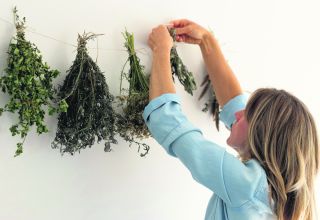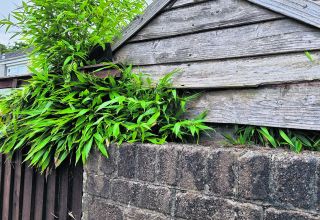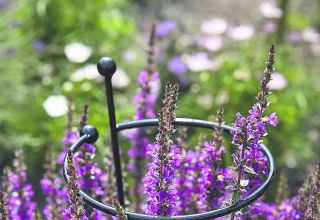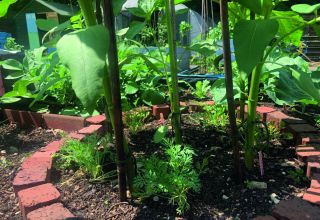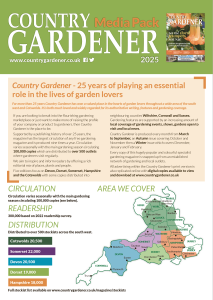February into March can be a mixed month weather-wise, from sunshine warm enough to take your coat off, to snow or heavy freezing rain. So it’s all a question of timing. On good days, take time to get out in to the garden to work and look around and you will see that it is about time to make a start.
If the ground isn’t too frozen or waterlogged, you can dig the soil over, or turn any compost that you have. Tidy up any debris on beds and the lawn, if it isn’t too wet or frozen to walk on. Get organised and buy all the seeds and compost that you are going to need for the coming months.
The bulbs may be up among the wreckage of the winter, spearing the ground with signs of the new season. This is the clue that the beds need clearing. The remains of last summer’s perennials and the leaves that fell among them were left deliberately, and the recycled foliage and stems should have been pulled into the soil by the earthworms, and will now be improving the humus content.
Some gardening jobs in February and March will help set the garden up for the rest of the year.
It is a good time to mulch your borders, as long as the soil is wet. Mulch acts as a barrier against weeds, can provide nutrients, keeps the soil moist and insulates roots from the cold. Before you start, make sure you have thoroughly weeded the bed and that you have sufficient mulching material – this could be leaf mould, compost, well-rotted manure or bark chippings.
Always leave a gap around the stem of plants.
A new hedge for a new season
Planting a new hedge is always one of those things which get included in the planning stage for a new season and then somehow gets forgotten in the rush to get early season things done in the garden.
It may be getting cold in the air, but the soil is still retaining some warmth. So yes, it is a good time to plant that hedge you have always promised yourself.
Food crops from the gutter
More and more gardeners are using gutter pipes to sow vegetables – especially salads. It is the best way, if you don’t have lots of room in your garden, and it keeps everything easy to look after and under control. Radishes can be eaten straight from the gutter – they don’t need to see any garden and you’ll have a salad feast within six to eight weeks. Also sow peas in guttering just fill the gutter with soil, and then place the pea seeds on the top of the soil at regular intervals along the line. don’t push them in until you’ve laid it all out – that way you won’t forget where you’ve sown them!
 Tidy up your hydrangeas
Tidy up your hydrangeas
Deadheading hydrangeas is one of the best garden tasks for late February/early March, before new growth starts appearing. It’s best to leave the flowers on the plant over the winter as this protects it from the worst of the weather. For ‘Aspera’ hydrangeas there is no need to radically reduce the size of the shrub; just cut the flower close to a main stem. For mopheads and cinerea types, more pruning is generally required: cut to about one-third of last season’s growth. Shred the cuttings, or cut them up into sections, and place them in your compost heap.
 Timing is everything when pruning clematis
Timing is everything when pruning clematis
The correct time and method for pruning clematis depends on whether the plant flowers on old or new wood. Some varieties produce young shoots from which they will flower within the same year. While others flower on shoots grown in the previous year. Clematis plants are grouped based on their pruning requirements and you can usually identify which group they are in based on when they flower.
February is the perfect time for pruning group 3 Clematis, before they start active growth. Group 3 Clematis include late-flowering species which will be in bloom from summer to late autumn, flowering on stems grown in the same year.
These clematis flower on new stems, so you can afford to cut away a large amount of the plant’s old stems, resulting in rapid regrowth and flowering within the same year. Cut all of the stems of the plant down to a pair of strong buds 20-30cm above ground level.
Last chance to prune apple and pear trees
There is still time to prune back your apple and pear trees by the end of February. If you don’t, your harvest may not as be as good because older branches won’t bear as much fruit as newer, fresh, healthy branches.
This pruning is only for open apple trees though, not espaliers, cordons or fan-trained apples (you should prune these in July and August). When you’re pruning, bear in mind that you want to let light and air into the branches and prune to form the tree into a goblet shape.

Time to get sowing and growing
- Order your potatoes and chit seed potatoes, standing them in trays in a light but frost-free position. Check last year’s potato bed for any stray little ones left over from last year and remove to prevent any disease spreading.
- Prepare the ground for planting asparagus.
- Sow a pack of onion seeds or slot some sets into trays for planting out once the clocks change in mid March
- Start to harvest early rhubarb – pick the stems of varieties such as ‘Timperley Early’ with a firm tug, rather than cutting them from the plant. Cover midseason rhubarb plants, e.g. ‘Stockbridge Arrow’, with forcers. This will elongate, tenderise and sweeten their stems.
Time is running out for cutting back vines. If you haven’t pruned the grapevines, do so immediately, as they will bleed if left too late. Once you have a framework of primary limbs, prune laterals back to one or two buds.
Key tasks for the next few weeks
- Top-dress your pots. Revitalise permanently planted pots by scraping out the top layer of old compost to a depth of two or three inches and adding the same amount of fresh. Fork it into the old compost surface.
- If you haven’t already got one, invest in a water butt to catch the spring rain in preparation for dryer months ahead.
- Make or buy a cold frame and/or compost bin.
- Reactivate your compost heap – take advantage of any warmer, drier weather and turn the whole thing into a new bin and water on a compost activator, such as comfrey juice or seaweed.
- Water indoor plants regularly now the weather is warmer.
- Start mulching bare soil. Use at least a couple of inches of green waste from your local council. After a warm spell, it’s a good time to jump in before weed starts to germinate.
- Check mowers are working, and service if necessary.


